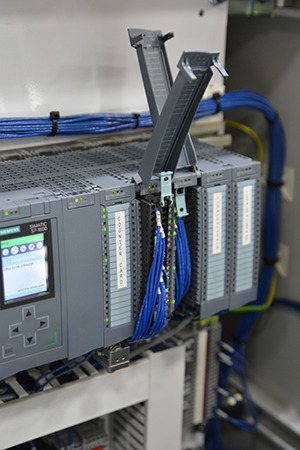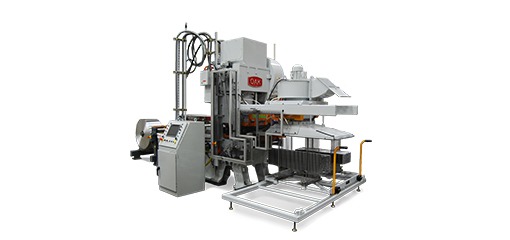Faster, better, more cost-effective processes are expanding business opportunities for this company around the globe.
Burr OAK Tool, Inc., Sturgis, MI, is a leader in the design and manufacture of custom production machinery for heating, refrigeration and air-conditioning OEMs. Plumbing, appliance, automotive and tube-component producers also depend on machinery and tooling from Burr OAK. Over seven decades, the company’s name has become synonymous with rugged, well-engineered equipment that delivers consistent, dependable results—equipment that has been installed at sites in more than 75 countries.
This OEM’s ability to thrive in the highly competitive global marketplace is enhanced by the systems it uses to run its own operations. A case in point is the company’s selection of innovative Siemens tools and capabilities to help expand its product offering and market penetration. According to Eric Lund, Controls and Software Engineering Manager at Burr OAK, the choice has resulted in faster, better, more cost-effective processes that let the company expand its reach in North America and abroad.
To target HVAC-industry customers in overseas markets like Asia and others, Burr OAK wanted to add an economical, yet high-quality, fin-press design to its product lineup. Working with Siemens, a trusted supplier of more than 10 years, the company identified Siemens’ S7-1500 Series PLC and its TIA (Totally Integrated Automation) Portal engineering software as state-of-the-art technologies that would help deliver the new FP 400 fin press within the desired price range.
Lund says Burr OAK was in the midst of developing the FP 400 when Siemens approached it about the new S7-1500 and the latest version (V12) of TIA Portal. Given the preliminary performance and pricing on the PLC and its integration with TIA Portal, Lund considered the technologies to be “a perfect fit” with the new fin press and the company’s interest in manufacturing a lower-price-point product.
Software benefits
In the launch of its new FP 400, Burr OAK realized significant benefits from the Siemens technologies. On the software side, the company was already using an earlier version of TIA Portal—a tool that combines PLC, PC-based-control, HMI (human/machine-interface) and network configuration in a single engineering en-
vironment. Despite their familiarity with the software, however, personnel soon discovered additional capabilities that were especially valuable in the production of the FP 400. These include:
Trace functions. Trace for real-time diagnostics is essentially a dynamic graphical editor that illustrates changing variables. Lund characterizes this function as akin to using an oscilloscope to see values of analog signals, such as the position or voltage of a motor. “At the same time,” he says, “I can overlay that with the state change of binary values and improve our timing, which is very important to Burr OAK.”
Using the trace function, engineers can put the logic they’ve written through its paces and verify performance. They can also leverage the feature to protect the expensive progressive dies Burr OAK uses in its machines—something that’s critical to do as the tooling shifts in and out, says Lund, again stressing the importance of timing.
“Shifting the tooling at the wrong spot could ruin it,” he explains. “Having data that shows the position of the ram and when the tooling is coming in and out lets us ensure that we are operating in a safe position.” TIA Portal in general, and the tracing function in particular, can validate that the written software is functioning as expected and help protect the dies by adjusting the timing precisely.
Project organization. The file tree in TIA Portal helps the Burr OAK team organize project elements. “Multiple pieces of equipment are being controlled within the PLC,” says Adam Broadwater, the company’s Research and Design Engineer. “With the file tree, I can sort my function blocks and data blocks into a logical folder structure. That was not available in other editors.” This capability lets Broadwater condense projects (i.e., when he’s working on something inside a project, he doesn’t need all of the other function blocks showing in the project tree). Similar capabilities are available for the PLC HMI screens.
Hardware benefits
From a hardware perspective, the S7-1500 Series PLC provided several advantages, including improved I/O modules and wiring techniques and diagnostic displays on the front of the unit.
With regard to the front-facing display, Lund, points out that while it was intended to help diagnose wiring faults, plant personnel found another application for it. The company had been striving to create software with a core code applicable to each machine so that personnel weren’t constantly writing unique code. “A core code runs the base machine,” he explains, “but each customized unit has different in-feed and out-feed options. So we created function blocks to operate each type of mechanism with some commonality among them.”

Siemens S7-1500 Series PLCs have played an important role in the development and production of Burr OAK Tool’s economical FP 400 fin press.
As a result, personnel can mix and match the options with the core code (and not be required to routinely debug and reproof all code as they customize the units). Moreover, when a new machine is commissioned, the code has already been debugged. A technician need only install the programmed memory card, start the controls, enable/disable the in-feed and out-feed options and debug the machine itself.
“For years,” Broadwater recalls, “the software engineer loaded the software on memory cards and passed the machine to a technician for start-up.” But, as the technician proceeded to set the options, he says, an error would invariably occur in the PLC program. “The problem would typically be associated with a wiring or plumbing mistake, not an error in the software.” Nonetheless, it would still be necessary for a software engineer to unplug from his desk, re-set-up on the shop floor, connect to the machine and help find the error. Now, with the display-screen and diagnostic capabilities of the S7-1500, company technicians can use the interface to get into the PLC program and determine the errors present. Referring to machine schematics, they can establish what’s wrong without involving a software engineer.
This creative use of the display, in turn, has led to a quicker, easier machine-commissioning process. Full diagnostic information is available—no PC required. With some basic training on the technology, technicians are able to solve most problems and complete the commissioning process themselves. Burr OAK’s software engineers, in turn, can remain at their desks, using their skills and time more efficiently.
Lund acknowledges, however, that Burr OAK personnel do use the display as Siemens intended. For example, while escorting visitors through the shop recently, an electrician stopped him to discuss why a new FP 400 unit wasn’t working. “I didn’t have my laptop with me,” says Lund, “but using the PLC interface, I diagnosed the problem [a network error between the PLC and an HMI] and got the equipment up and running again.”
Another important benefit of the new hardware involves the minimal amount of inventory associated with its use. The S7-1500 uses a standard terminal module across all I/O modules. “Our stockroom no longer needs to have one terminal module for the encoder card, another for the 32-point output card and yet another for the 16-point input card,” explains Broadwater. “The same one works for all applications. It is a standardized piece.”
Burr OAK personnel also appreciate the straightforward wiring procedures for the I/O modules. With the wiring location on the front of the unit, a technician simply pulls a terminal module out of the I/O position and it’s no longer physically connected to a PLC. Exposed and visible, the terminals are easily wired. Yet everything remains properly positioned—and the length of wire is correct when the job is complete. Broadwater notes that everything is also neat and clean: A spring-loaded latch pops the terminal out and brings it to a resting position, then takes it back and locks it in. “This feature,” he says, “is not only efficient, it creates a nice-looking panel.”
Running the numbers
Lund and Broadwater agree that the Siemens S7-1500 and TIA Portal have delivered well for Burr OAK Tool. Broadwater says the two technologies have reduced engineering time about 30%. “We weren’t holding a stopwatch to our activities,” he explains, “but everything moves faster with TIA Portal. And commissioning the machines in the I/O modules is saving a lot of time as well.”
It’s a strong business case. Burr OAK now builds and ships as many as 50 fin presses annually. “In the past,” Broadwater says, “it took at least two hours of a software engineer’s time per machine to debug errors. Those hours are now saved because the technicians can debug the units themselves.” MT
About Burr OAK Tool
Established in Burr Oak, MI, in 1944, Burr OAK Tool, Inc., was founded by a small group of men with a vision to provide tools, dies and fixtures to local companies. It has remained family-owned for three generations, and retains the roots and values of its original founders.
Now located in Sturgis, MI, Burr OAK supplies machines, tools and expertise to the heat-transfer and tube-processing industries. Its product lineup includes fin dies, fin lines, tube expanders, tube-cutoff machines, tube-bending equipment and coil- forming units.
The company guarantees that its machines are finished and thoroughly tested, and, most important, that they will function properly from the time they are installed in a customer’s plant and throughout their production life.
Today, from several world-class manufacturing and assembly facilities spread across Sturgis, and its service centers in India, China and Europe, the company meets the needs of customers across the globe.
For more information, visit burroak.com.



